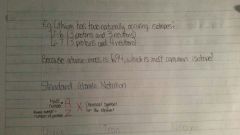![]()
![]()
![]()
Use LEFT and RIGHT arrow keys to navigate between flashcards;
Use UP and DOWN arrow keys to flip the card;
H to show hint;
A reads text to speech;
59 Cards in this Set
- Front
- Back
|
5 Main Points |
All matter is made up of tiny particles with spaces between them Different substances are made up of different types of particles Particles are in constant motion Particles move faster as its temperature increases Particles attract each other |
|
|
States of Matter |
Solid: Definite volume and shape Lowest energy Liquid: Definite volume and takes up the shape of the container Gas: takes volume and shape of the container Highest energy |
|
|
Qualitative property |
Property of a substance that is NOT measured and does NOT have a numerical value |
|
|
Quantitative Property |
Property that is measure and has a numerical value |
|
|
Physical Changes |
Change of Shape Change of volume or size Change of state |
|
|
5 signs of chemical change |
Change of colour Change of odor Bubbles are visible/gas produced A new solid is seen (precipitate) Change in temperature (heat or light is produced) |
|
|
Formula to find density |
D=M÷V |
|
|
Formula to find Volume |
V=M÷D |
|
|
Formula to find Mass |
M=D×V |
|
|
DEFINITION: Characteristic Physical Property |
A physical property that can identify a substance |
|
|
4 Characterisitic Physical Properties |
Density Freezing Point Melting Point Boiling Point |
|
|
Effect of salt on ice |
Alter the freezing point to -16°C |
|
|
Unusual behaviour of Water |
Solid form is less dense than liquid form Water particles occupy more space in their solid form |
|
|
Element |
A pure substance that can't be broken down into simpler chemical substance |
|
|
Element Symbol |
Abbreviation for a chemical element |
|
|
Compound |
Chemical substance composed of two or more different elements (Chemically joined) |
|
|
Metals location on P.Table |
Left side of staircase |
|
|
Non-metals location on P.Table |
Right side of staircase |
|
|
Metalloids characteristics |
Element that has properties of both metals and non metals |
|
|
Metals characteristics |
Lustrous Malleable Ductile Conduct heat and electricity |
|
|
Non-metal Characterisitics |
Gas Dull powdery solid Don't conduct heat and electricity |
|
|
Metalloids location on P.Table |
Along the staircase |
|
|
Periods in the P.Table |
Horizontal row Show trends of increasing or decreasing reactivity |
|
|
Groups/Columns/Families |
Vertical columns Elements in the same group have similar properties |
|
|
# of valence electrons in Alkali Metals |
1 valence electron |
|
|
# of valence electrons for Alkaline Earth Metals |
2 valence electrons |
|
|
# of valence electrons in Halogens |
7 valence electrons |
|
|
# of valence electrons for Noble Gases |
8 valence electrons |
|
|
Reactivity trends: Metals |
Most reactive metals left side Further down, more reactive |
|
|
Reactivity trends: Non-Metals |
Most reactive on upper right side Further up, more reactive |
|
|
Substances made up carbon |
Charcoal Graphite Diamond |
|
|
Chocolate chip Muffin theory Plum pudding |
Thompson |
|
|
Proposed that all matter can be divided into smaller pieces unil a single indivisible particle is reached |
Democritus |
|
|
Billiard Ball Model |
John Dalton |
|
|
Gold foil experiment |
Rutherford |
|
|
Discovered the neutron |
James Chadwick |
|
|
Electrons orbit the nucleus on specific orbitals/energy levels |
Niels Bohr |
|
|
Similarities and differences of Chocolate chip Muffin theory and Bohr's theory |
|
|
|
Atomic number |
# of protons in the nucleus |
|
|
Atomic Mass |
Mass of an atom in atomic mass units (amu) |
|
|
Mass Number |
# of protons and neutron in atoms nucleus |
|
|
Isotopes |
An atom with the same number of protons but different number of neutrons |
|
|
Standard Atomic Notation |

|
|
|
Maximum # of electrons in shells |
2 8 8 18 |
|
|
Molecules |
Made up of two or more atoms joined together by chemical bonds |
|
|
Molecular Elements |
Atoms of the same elements joined together O2 |
|
|
7 diatomic molecules |
O2 H2 N2 F2 Cl2 Br2 I2 |
|
|
Compound |
Atoms of different elements joined together |
|
|
Chemical formulas |
Represent elements that exist as molecules and all compounds |
|
|
2 things Chemical Formulas indicate |
Which elements are present How many atoms of each element are found |
|
|
Ion |
Form when an atom loses or gains one or more electrons without changing the # of protons |
|
|
Cation "CAT-ION" |
Positive charged ion "PAW-sitive" |
|
|
Anion (ANion A N....) |
Negative charged ion |
|
|
Octet Rule |
Atoms gain or lose electrons in order to have a full valence shell |
|
|
Why are Noble Gases stable? |
They have full valence shells |
|
|
Why are Alkali Metals highly reactive? |
They only have one valence electron |
|
|
Metal + Metal |
Metal alloy |
|
|
Metal + Non-Metal |
Ionic Compound |
|
|
Non-Metal + Non-Metal |
Covalent Bonds |

